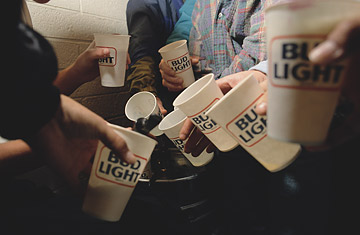
Every year around this time, millions of American kids graduate from high
school, throw massive parties and get drunk. Police end up arresting a lot
of these kids, causing them legal trouble for months or even years. So,
every year around this time, there’s a new debate about whether we should
lower or even abolish the legal drinking age.
What’s different this time is that an entire organization — a
conspicuously sober group led by a former college president — now exists
to promote the idea that drinking should be lowered from 21 to 18. John McCardell Jr.,
an esteemed historian of the American South and former head of Middlebury
College, founded Choose Responsibility in 2006 to argue in favor of licensing 18-to-20-year-olds
to drink after they have completed an exhaustive 42 hours of instruction in
the history, chemistry, psychology and sociology of alcohol — which could
even include sitting in on an AA session for three hours.
McCardell has won some favorable news coverage, and when I first e-mailed him last
year, I told him his idea sounded persuasive. After all, in almost every
other legal and cultural respect, you’re an adult at 18. You can vote, adopt
children, sign up for Iraq or become a commercial pilot at 18. Treating
alcohol differently helps turns it into a holy grail of adulthood. In a
224-page white paper he co-authored, McCardell also argues that raising the
minimum age to 21 — as states did after the federal government threatened
to withhold highway funds in 1984 — “forced alcohol consumption behind
the closed doors of [dorms] and fraternity basements. Always
unsupervised, done in secret and too often excessive, this style of drinking
has no doubt been responsible for the alarming rise in rates of so-called
‘binge’ drinking seen at colleges.”
McCardell’s argument seems logical, but it falls apart once you look at the statistics on underage drinking. First of all, while binge
drinking is a serious problem, the data do not show that it has gotten worse
since states raised their drinking age. As researchers John Schulenberg of
the University of Michigan and Jennifer Maggs of Penn State point out in a
2002 Journal of Studies on Alcohol paper, “during the past two
decades, despite many social, demographic, political and economic changes
— and despite dramatic shifts in cigarette and illicit drug use — rates of frequent heavy drinking among those ages 19 to 22 have shifted
little.” According to the University of Michigan’s Monitoring the Future study, the proportion of those 19- to 22-year-olds
who reported consuming five or more drinks in a row in the two weeks prior
to being surveyed actually fell from 40.7% in 1984 to 38.1% in 2006. And no
researchers have documented an increase in the percentage of
alcohol-poisoning deaths among college students, although the raw number has
probably increased with the growing college population.
There’s a more basic problem: If the drinking age is lowered to 18, who
is to provide the supervision that McCardell suggests? Surely not bar owners
who want to sell them as many drinks as possible. It’s unclear why shifting
the venue of drinking from frat houses to bars will help solve the problem
of hard-core student drinking.
Finally, lowering the drinking age to 18 would stop infantilizing college
students, but it would probably kill more of them in traffic accidents. In
2006, 2,121 people ages 16 to 20 died in alcohol-related fatalities on U.S.
roads, according to data compiled for me by the National Highway Traffic
Safety Administration; in 1984, the figure was 4,612. McCardell has argued
that improvements in seat-belt use and car safety partly explain these
gains, but traffic fatalities unrelated to alcohol have increased 21% in
that age group during the same period .
Choose Responsibility supporters have also claimed that other countries
that haven’t raised their drinking ages — including Canada and the United
Kingdom — saw their drunk-driving fatalities drop even faster than in the
U.S. But that’s simply not true. In 1984, 45% of U.S. drivers killed in
accidents turned out to have been legally drunk. That percentage was just
32% in 2006. By contrast, the percentage of drivers killed in Great Britain
who were drunk actually rose slightly, from 19% in 1989 to 21% in 2005.
McCardell is right that the U.S. has an odd and dysfunctional
relationship with alcohol, and his voice is refreshing in a debate dominated
by MADD pieties. But lowering the drinking age is going too far.